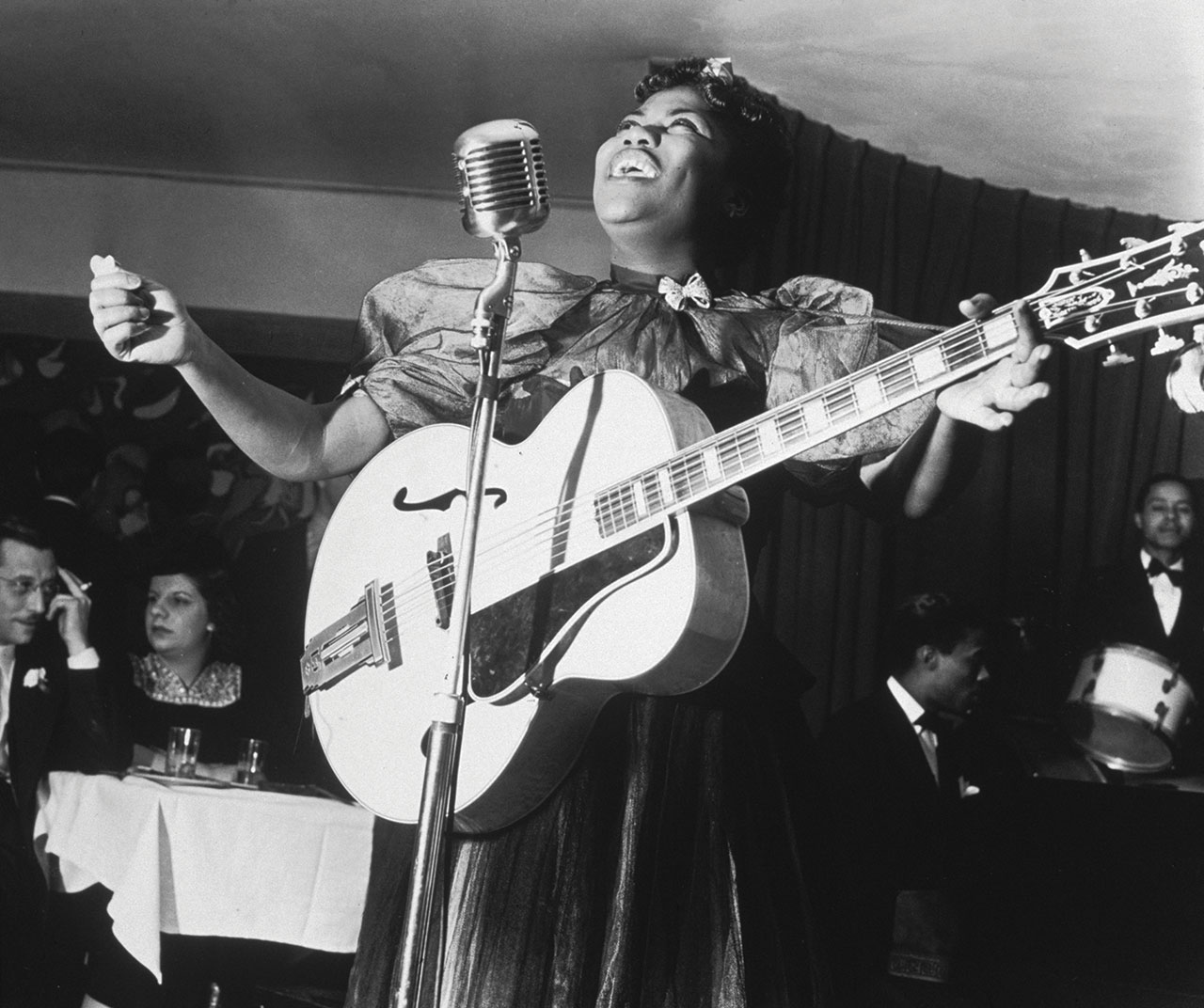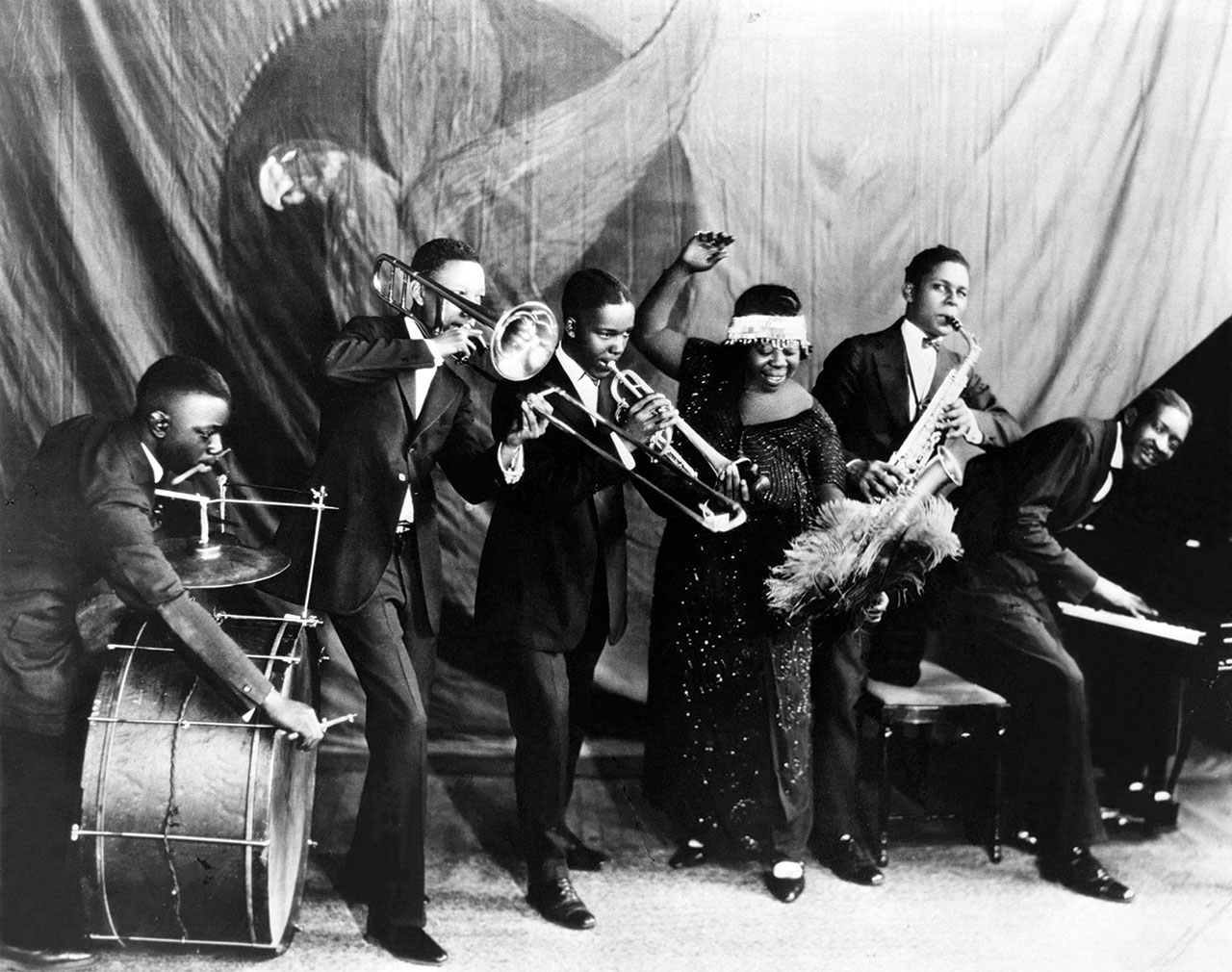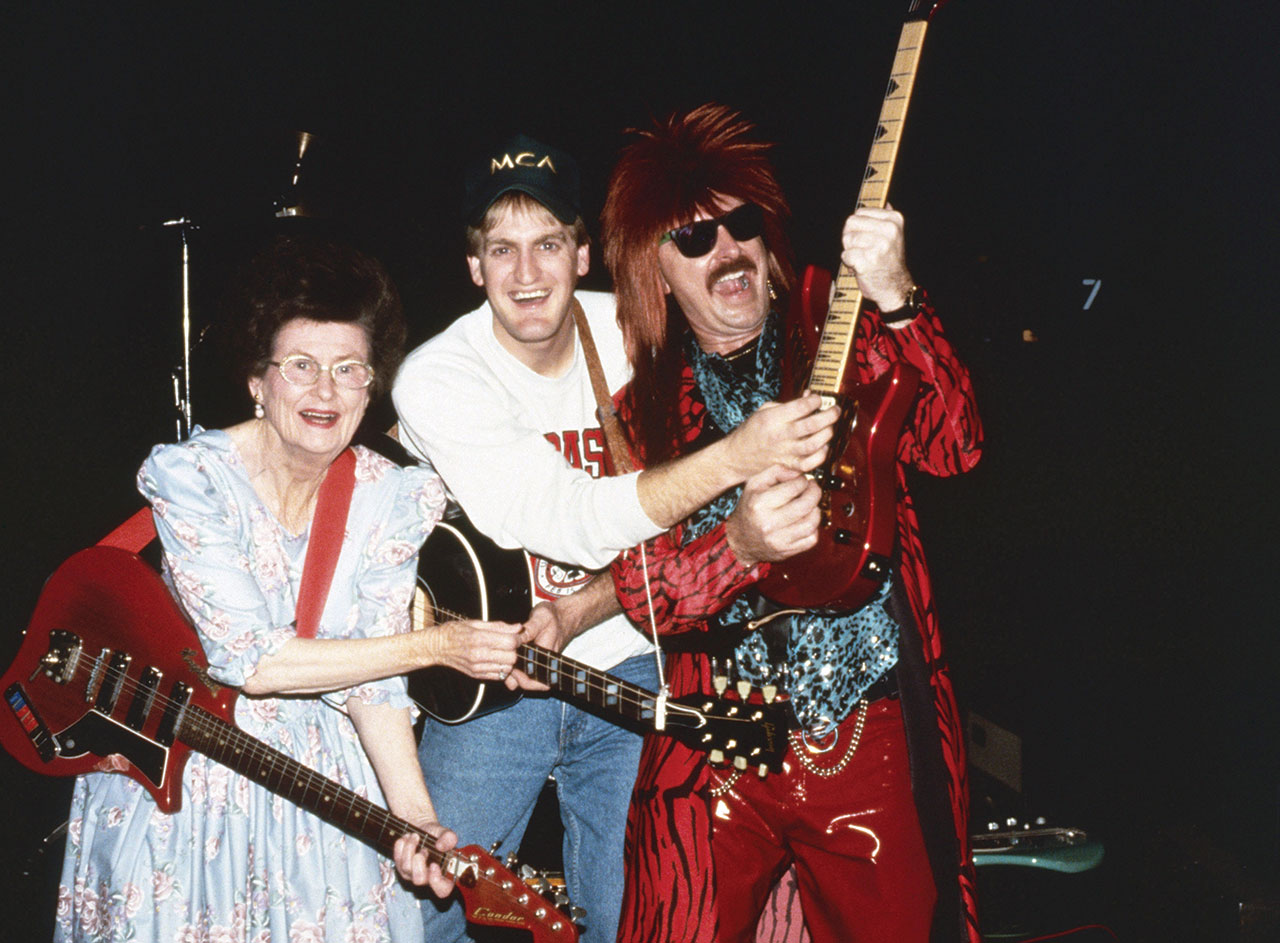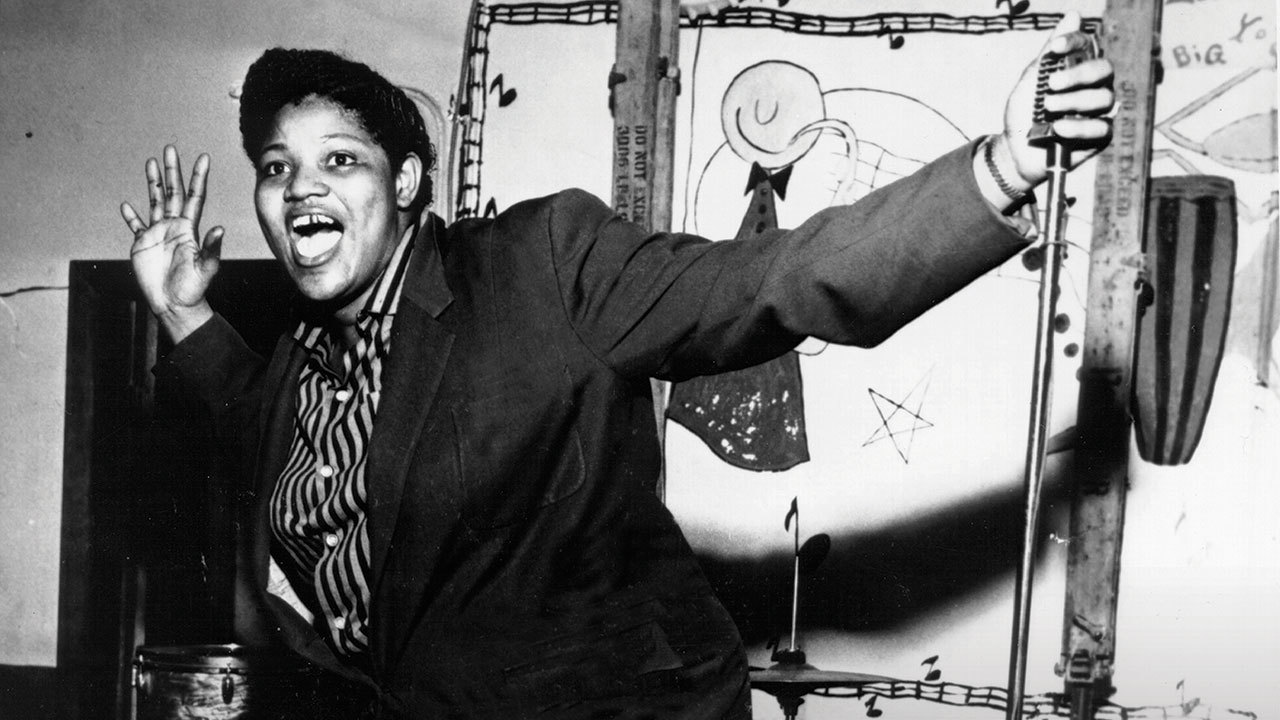‘Papa likes his bourbon, mama likes her gin/Papa likes his outside women, mama likes her outside men…’
Ma Rainey, Barrel House Blues, 1923
As James Brown sang: ‘This is a man’s world, but it wouldn’t be nothing without a woman…’
Those wise words hold true for the male-dominated world of rock’n’roll. But when the familiar musical history gets trotted out, names such as Bessie Smith, Cleo Gibson, Ida Cox, Sister Rosetta Tharpe, Memphis Minnie, the Harlem Playgirls, Sippie Wallace, Big Mama Thornton, Ruth Brown and Wanda Jackson are usually absent from the conversation, or at best relegated to passing mentions.
But long before Chuck Berry, Elvis and Rock Around The Clock made ‘rock’n’roll’ a household word, there was a strong, steady, matriarchal line of blues, gospel, jump and R&B singers who contributed just as much to its stylistic core as the guys.
The first ever blues record was by a woman. Mamie Smith’s Crazy Blues (1920) was a hit, selling 75,000 copies in its first month alone, and starting a brief but vital period when female blues singers were prized more than their male counterparts (Smith’s record was produced by Ralph Peer, who also discovered the Carter Family and Jimmie Rodgers).
Columbia Records, one of the early major labels, paid stars such as Smith, Ma Rainey and Victoria Spivey a flat rate of $100 to $130 per song, while the men usually got $20 to $30 (there were no artist royalties then). On stage the girls were singing the blues to big audiences from Los Angeles to St. Louis to New York, booked on what was called the TOBA (Theatre Owners Booking Association), a black vaudeville circuit that covered 67 American cities. For post-WWI black listeners who had migrated to metropolitan areas such as Chicago and St. Louis, these singers, most of whom came from the rural south, were living symbols of that move and its possibilities.
One woman who played that circuit stands out as almost a prototype for what we now think of as a rock star. The great bluesman Big Bill Broonzy once said of Memphis Minnie that she “can pick and sing as good as any man I’ve ever heard; she can make a guitar cry, moan, talk and whistle the blues”. Broonzy would know. He’d been bested by Minnie in two picking contests in Chicago, one in 1933, the other in 1949. The latter was judged by no less than Muddy Waters.

Born Elizabeth Douglas in 1897 in Algiers, Louisiana, Minnie rolled the contrasts of a woman and a man into a charismatic, larger-than-life package. Beautiful in chiffon ball gowns and fancy hairdos, she took snuff and spit tobacco (she could spit mid-song and not miss a beat). She drank, gambled, told filthy jokes and on stage often sat in a provocative way to show off her panties.
In lean times, Minnie is said to have supplemented her income with prostitution, which was not uncommon for some early female blues singers. She didn’t suffer fools, and was even rumoured to have sliced off the arm of a dude who tried to mess with her.
All of that vivid living funnelled straight into her music, from the acoustic blues of the late 1920s to the electric records she made for Chess spin‑off label Checker in the 1950s. She started playing banjo and guitar at the age of seven, and by her teenage years was performing as Kid Douglas anywhere there was an audience – riverboats, store openings, even with Ringling Brothers Circus for a spell. She eventually settled in Memphis, where she acquired her stage name.
In 1929, she and her first husband, guitarist Joe McCoy, recorded When The Levee Breaks, a song they co-wrote about the Great Mississippi Flood. Minnie’s finger-picking guitar playing on the record is miraculous: almost like the stride piano of Fats Waller channelled through six steel strings. Forty years later the song was introduced to a new generation by Led Zeppelin. Minnie and Joe had other hits with Hoodoo Lady, Bumble Bee Blues and Can I Do It For You?, all of which now sound like templates for early Rolling Stones and Kinks records.
In the 1940s, Minnie and her second husband, Ernest ‘Little Son Joe’ Lawlars, had their biggest hit, with the suggestive Me And My Chauffeur (‘He drives so easy, I can’t turn him down’). Minnie went electric, amping up her style. In 1942, the poet Langston Hughes described her guitar sound as “a musical version of electric welders plus a rolling mill… with a rhythm so contagious it makes the crowd holler out loud”.
In 1957, Minnie suffered a heart attack, then two years later a stroke, which ended her performing career. She died in 1973. In 1980 she was inducted into the Blues Foundation Hall Of Fame. She has influenced scores of female artists, including LaVern Baker (Minnie’s niece), Maria Muldaur (who made a tribute record to Minnie in 2012) and, most prominently, Bonnie Raitt (who paid for Minnie’s headstone).

Muddy Waters was only partially right when he sang, ‘The blues had a baby and named it rock’n’roll,’ for it surely wasn’t a virgin birth. The other parent was black southern gospel music. The whoops, hollers and vocal flourishes that were connected to the unbridled union with the holy spirit made their way into rock’n’roll, where they expressed a more earthbound union.
And no one embodied that sacred-profane hand-off from church to juke joint better than Sister Rosetta Tharpe. At the age of four, billed as ‘Little Rosetta Nubin, the pint-sized singing and guitar playing miracle’, she tore through the southern touring circuit known as the Gospel Highway. By her early twenties she was thrilling audiences at Carnegie Hall and the Cotton Club. When she got married in 1951, 25,000 people paid to watch her wedding.
On stage, in her Sunday best and wielding a Gibson SG, she peeled off wild, primal guitar licks, and raised the roof with her soul-deep voice. Little Richard, Chuck Berry and Johnny Cash all acknowledged her as a major influence.
She was born in Cotton Plant, Arkansas, in 1915. Her father’s identity is unknown; her mother was a musician and evangelist preacher in the Church of God in Christ. It was one of the few churches that allowed women to preach, and also encouraged musical expression beyond the hymn book. It was an ideal environment for a child prodigy, and Rosetta’s course was set early.
After becoming a star in her mum’s church in Chicago, she moved to New York, where the legendary talent scout John Hammond introduced her to big-city audiences. Signed to Decca Records, and singing with Lucky Millinder’s orchestra, Rosetta shocked her gospel fans by recording saucy material like Four Or Five Times and I Want A Tall Skinny Papa. Her 1945 record of Strange Things Are Happening is one of a handful of candidates for the first-ever rock’n’roll record.
But it was really on stage where Rosetta most embodied the rock’n’roll spirit. There isn’t much existing footage of her, but one clip, from 1964, shot on a train station platform in Manchester, England, is revelatory. The confidence, the sexuality… it’s pure rock’n’roll. But most of all there’s the voice. It’s a voice of the human spirit, a voice that, no matter where or who you are, will reach across decades to rivet you in place.
Sister Rosetta Tharpe died from a stroke in 1973, aged 58. Her epitaph reads: “She would sing until you cried and then she would sing until you danced for joy. She helped to keep the church alive and the saints rejoicing.”
- A farewell to kings: How women are rejuvenating prog rock
- Pandora festival aims to celebrate women in music
- Led Zeppelin Vs Memphis Minnie: When The Levee Breaks
- Classic Rock, Metal Hammer, Prog & TeamRock launch She Rocks month
By the early 1950s, all of this music that both African-American women and men were playing (radio dubbed it ‘race records’) – blues, gospel, jumpin’ jive (a special nod here to the amazing 40s-era all-female big band International Sweethearts Of Rhythm) and their pre-rock offspring, rhythm & blues – was the crossroads where white America started to discover black culture. And in rock’n’roll’s case, discover and appropriate it to make it ‘safe’ for white audiences.
In some instances, R&B hits were neutered beyond recognition – the sensuality of Ruth Brown’s Oh What A Dream got smothered by Patti Page’s version; Etta James’s steamy Roll With Me Henry was rendered saccharine by Georgia Gibbs (James later said: “She got a spot on Ed Sullivan while I was singing in some funky dive in Watts”). But there’s no better – and more conflict-ridden – example than Big Mama Thornton’s Hound Dog.
I once interviewed Jerry Leiber, the lyric-writing half of the legendary rock’n’roll songwriting team Leiber & Stoller, and he recalled the day in 1952 that they brought Hound Dog to blues shouter Thornton. “She was the biggest, baddest, saltiest chick we’d ever seen. She must’ve been three hundred and fifty pounds, and she had these razor scars all over her face. Like a lady bear. I handed her the words to the song, which were scribbled on a brown paper bag. When she started to sing, man, it just knocked us cold.”
The woman born Willie Mae Thornton in 1926 acquired that formidable presence and attitude at a young age – by necessity. She was 14 when her mother died, leaving Willie Mae to fend for herself. She ran away from home in Montgomery, Alabama to join the Hot Harlem Review, a travelling vaudeville troupe. Even as a teenager, Thornton had a way of wrestling songs to the ground, making them beg for mercy under her sheer force. For early examples, check out Mischievous Boogie and I Smell A Rat. She would later boast that her voice was “louder than any microphone”.
Of her early days on the road, Thornton told NME in 1972: “I learned to sing, blow harmonica, even play the drums, just by watching other people. I don’t read music but I know where I’m singing. If I hear a blues I like, then I try to sing it my own way. It’s always best to have something of your own. I don’t sing like nobody but myself.”
A stint with Johnny Otis led to her debut appearance at New York’s prestigious Apollo Theater. “That’s where they made their mistake,” Thornton said, with characteristic brass. “They put me on first. I was out there to make my name, and I did. I stopped the show. The manager told Johnny he was putting me to the top of the bill.”
Thornton’s Hound Dog, her most famous song – which sold more than half a million copies and went to No.3 on the R&B chart – would be similarly upstaged a year later by Elvis Presley’s version. Through the next few decades, Thornton continued to perform in juke joints and clubs, scraping out a living while battling a love for the bottle.
A volcanic set at the 1964 Monterey Jazz Festival apart, Thornton then followed the course of many American blues artists: touring through Europe, making albums that were mostly ignored back home. The best of her latter work is Big Mama The Queen At Monterey, featuring an all‑star backing band of Muddy Waters, Otis Spann and James Cotton.
Thornton died in 1984, aged 57. Her powerhouse singing was one of the major influences on Janis Joplin. After Joplin covered Big Mama’s self-written Ball And Chain in 1967, Thornton said: “That girl feels like I do.”
Sadly, Thornton’s record label had sold the publishing rights to the song without her knowing, so she never saw a penny from Joplin’s record.

The influence of these black female artists and more on the rock’n’roll boys’ club is undeniable. You hear Memphis Minnie’s guitar in Chuck Berry and Eric Clapton; Sister Rosetta’s unbridled spirit in Jerry Lee Lewis and Robert Plant; Big Mama Thornton’s growl in Elvis, of course. But less acknowledged is how their music led directly to the first two white guitar-slinging rock’n’roll women – both of them, coincidentally, named Jackson.
Cordell Jackson recorded a lot of demos at Sun Studios in the early 1950s, but Sam Phillips, Sun’s founder and a producer, never signed her. That didn’t deter Jackson. She learned how to engineer and produce, then started her own rockabilly label in 1956, cheekily called Moon. It took 30 years before she got her due, appearing on David Letterman, and in a TV commercial where she traded raucous licks with Stray Cat Brian Setzer.
The other Jackson made a bigger splash. Born in Maud, Oklahoma in 1937, Wanda Jackson grew up in a musical family, soaking up the western swing of Bob Wills and Spade Cooley. By the time she was 12 she was winning local talent contests and singing on the radio. At 17 she hit the road, opening for Elvis Presley. Before long, the two of them were dating. Jackson credits Elvis with encouraging her to branch out from her country roots and “try this new style”. Within two years – after outraging the Grand Ole Opry with her daring outfits and suggestive hits like Fujiyama Mama and Mean Mean Man – Jackson was being hailed as the Queen of Rockabilly.
“I wasn’t being sexy with my songs,” Jackson told me in an interview in 2011, “I was being feisty. And there’s a difference. I was cute and young, saying whatever was on my mind, but it was always clean. The public liked me fine. The problem was that the radio wouldn’t play my records. They didn’t want to accept us kids and rock’n’roll into the adult world.”
By the time The Beatles came along, most of the major rock’n’rollers were dead or sidelined. Wanda soon went back to her roots, recording straight-up country albums from the 1960s onwards. In 2010, Jack White produced a record of the 73-year-old singer, stoking the rockabilly fire that she’d started 50 years earlier.
Despite helping to provide the foundation of rock’n’roll, almost all of these blues, gospel and R&B singers were left at the crossroads when the new music exploded commercially in the mid-1950s. But they brought decades of sexuality, swagger, self-determination and strong female consciousness to the borderline, where they relayed it, consciously or not, to the next generation. So before we plunge into the world of contemporary female rockers, from Janis Joplin to Joan Jett to Stevie Nicks and others, take a moment for these great ladies who provided the inspiring shoulders for others to stand on.
Wanda Jackson’s clear-eyed assessment of a woman’s place in music in the 20th century rings as a summary for all of those pioneers: “In the 1950s, a woman was either a secretary, a nurse or a housewife. But to tell you the truth, I never even prepared for any other kind of career. So I guess I had to make it, because I wasn’t qualified for anything else. My only passion was music and singing and entertaining, and I always kept my main goal in front of me.”

